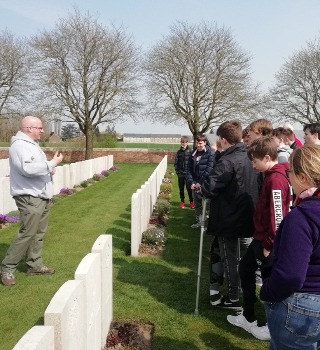On Sunday 31st March 21 students from the 3rd, 4th and 5th forms, accompanied by Mr Batten, Mr Hudson, Miss Merris and Reverend and Mrs Weaver, embarked on a three-night trip to Belgium and France as part of their studies of the Great War.
The trip began with a visit to Lijssenthoek Military Cemetery near Poperinge, where pupils were given a talk by Old Bloxhamist and historian Matthew Dixon about Wilfrid Bury, an OB who fought in the 1st Battalion of The Canadian Mounted Infantry. Pupils also visited the grave of nurse Nellie Spindler, the only woman buried at Lijssenthoek among more than 10,000 men.
After this, the group moved on to Sanctuary Wood to follow in the footsteps of soldiers and walk through still-intact trenches and tunnels. The students and staff continued on to Ypres, where Reverend Weaver delivered a poignant service of dedication of the school’s new plaque at St. George’s Church. Their day in Ypres concluded with a visit to the Menin Gate Memorial to the Missing, a monument bearing the names of over 54,000 soldiers who died in the Ypres Salient, who have no known grave. A wreath was laid with the message ‘In grateful thanks to all those Old Bloxhamists who gave their lives, from all current pupils‘.
The second day of the trip involved visits to Essex Farm Cemetery, Langemark Cemetery and Hellfire Corner en route to Passchendaele. Miss Merris was able to visit the grave of a family member, Thomas Barett V.C.’in Essex Farm, and students discussed the stark contrast between British Cemeteries and the sombre German Langemark.
A visit to Larch Wood Cemetery saw pupil Lizzie J plant a cross at the grave of her ancestor Pte William Henson of the 1st Northamptonshire Regiment. The group continued on to Tyne Cot Cemetery and pupils Ralph R’and Hannah B placed crosses for the two Old Bloxhamists commemorated there, Pte. Horace Kruger and Lt. Geoffrey Owen Thomas.
On the’third day of the trip the group visited the Somme, the location of one of the most infamous battles in human history. Pupils and staff walked from Hawthorn Ridge through Beaumont-Hamel to Newfoundland Park, where the ground is still scarred with craters and trenches.
After a brief visit to the Ulster Tower Memorial to Northern Irish soldiers, the group spent time at the British Cemetery in Pozieres to visit the graves of Old Bloxhamists Lt. Arthur Stevens, Capt. Basil Brooks and the memorial to Major Robert Villar, whose body was never found. Pupil Tom R also had the opportunity to place a cross at the grave of his ancestor Pte. Arthur Lane.
Next the group visited the Thiepval Memorial to the Missing and in pairs placed crosses in memory of the 11 Old Bloxhamists among the 72,000 names immortalized there. This was followed by a talk from Reverend Weaver about the contribution made to the War by troops from the British Empire. The third day came to a close after a visit to the Lochnagar Crater and the Somme 1916 Museum in the town of Albert.
The’fourth and final day of the trip included a visit to Wellington Quarry, where the troops prepared before the Arras Offensive in April 1917, and a walk around the site of the battle of Vimy Ridge, with its imposing memorial to the Canadian forces.
Mr Batten had this to say about the experience: “We packed a lot into our four days, but the pupils were engaged and enthusiastic at all times, and the opportunity to visit the graves of soldiers with a personal connection to members of our party was a highlight of the trip.”
To find out more about the Old Bloxhamists who fought in WWI, visit Matthew Dixon’s informative website here, or visit the Old Bloxhamist Archive here.


